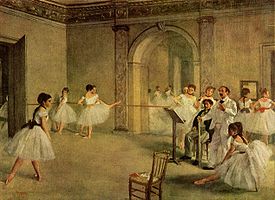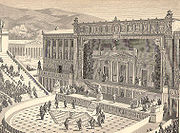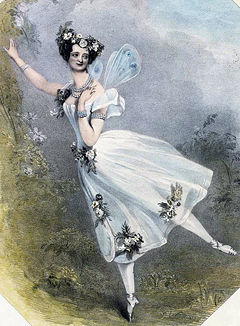
Classical ballet
Encyclopedia

Classical Ballet is the most formal of the ballet
Ballet
Ballet is a type of performance dance, that originated in the Italian Renaissance courts of the 15th century, and which was further developed in France and Russia as a concert dance form. The early portions preceded the invention of the proscenium stage and were presented in large chambers with...
styles, it adheres to traditional ballet technique
Ballet technique
The core technique of ballet has only minor regional variations globally. Various training methods have been devised, these produce a different physicality of performance and aesthetic results...
. There are variations relating to area of origin, such as Russian ballet
Russian ballet
Russian ballet is a form of ballet characteristic of or originating from Russia. In the early 19th century, the theaters were opened up to anyone who could afford a ticket. There was a seating section called a rayok, or 'paradise gallery', that consisted of simple wooden benches...
, French ballet
French ballet
The "École Française" , is characterized by an emphasis on precision, elegance, and sobriety.Mega-star dancer & choreographer Rudolf Nureyev choreographed re-worked versions of the great academic classic ballets , and directed the Paris Opera...
, British ballet
British ballet
British ballet is most recognised for two leading methods, those of the Royal Ballet School and the Royal Academy of Dance. The identifying characteristic of British ballet is the focus on clean, precise technique and purity of line that is free of exaggeration and mannerisms...
and Italian ballet
Italian ballet
Italian ballet is a term used to describe the training methods and aesthetic qualities seen in classical ballet in Italy. Italy has a long history with ballet, and it is widely believed that the earliest predecessor of the modern dance form originated in the Italian courts of the Renaissance,...
. The Vaganova method
Vaganova method
The Vaganova method is a ballet technique and training system devised by the Russian dancer and pedagogue Agrippina Vaganova . Fusing elements of traditional French technique from the romantic era, with the athleticism and virtuosity of the Italian school, the method is designed to work the body...
, named after Agrippina Vaganova
Agrippina Vaganova
Agrippina Yakovlevna Vaganova was an outstanding Russian ballet teacher who developed the Vaganova method - the technique which derived from the teaching methods of the old Imperial Ballet School under the Premier Maître de Ballet Marius Petipa throughout the mid to late 19th century, though...
, the Cecchetti method
Cecchetti method
The Cecchetti method is a ballet technique and training system devised by the Italian ballet master and pedagogue Enrico Cecchetti . The Cecchetti method, is a strict training system with special concern for anatomy within the confines of classical ballet technique, and seeks to develop the...
, named after Enrico Cecchetti
Enrico Cecchetti
Enrico Cecchetti was an Italian ballet dancer, mime, and founder of the Cecchetti method. The son of two dancers from Civitanova Marche, he was born in the costuming room of the Teatro Tordinona in Rome. After an illustrious career as a dancer in Europe, he went to dance for the Imperial Ballet in...
and the Bournonville method, named after Auguste Bournonville are Russian, Italian and Danish respectively and derive from the original French method.
Classical ballet is best known for its unique features and textures, such as pointe work
En pointe
En pointe means "on the tip" and is a part of classical ballet technique, usually practised using specially reinforced shoes called pointe shoes or toe shoes. The technique developed from the desire for dancers to appear weightless and sylph-like and has evolved to enable dancers to dance on the...
, turn-out of the legs
Turnout (ballet)
In ballet, turnout is a rotation of the leg which comes from the hips, causing the knee and foot to turn outward, away from the center of the body. This rotation allows for greater extension of the leg, especially when raising it to the side and rear...
, and high extensions; its graceful, flowing, precise movements; and its ethereal qualities.
History of Ballet

Technique

Training
There are at least seven styles of training in classical ballet, the most common being Vaganova methodVaganova method
The Vaganova method is a ballet technique and training system devised by the Russian dancer and pedagogue Agrippina Vaganova . Fusing elements of traditional French technique from the romantic era, with the athleticism and virtuosity of the Italian school, the method is designed to work the body...
(Russian), Cecchetti method
Cecchetti method
The Cecchetti method is a ballet technique and training system devised by the Italian ballet master and pedagogue Enrico Cecchetti . The Cecchetti method, is a strict training system with special concern for anatomy within the confines of classical ballet technique, and seeks to develop the...
(Italian), Royal Ballet School
Royal Ballet School
The Royal Ballet School is one of the most famous classical ballet schools in the world and is the associate school of the Royal Ballet, a leading international ballet company based at the Royal Opera House in London...
and Royal Academy of Dance
Royal Academy of Dance
The Royal Academy of Dance is an international dance education and training organization, and examination board that specialises in the teaching and technique of Ballet. The RAD was established in London, England in 1920 as the Association of Operatic Dancing of Great Britain, and received its...
methods (English), and Balanchine method
Balanchine method
The Balanchine Method is a ballet technique and training system devised by the Russian dancer and choreographer George Balanchine and initially used at the New York City Ballet. It requires extreme speed, very deep plie, unconventional arms and hands, and emphasis on lines, especially in decale...
(American). The techniques found in classical ballet are a framework for many other styles of dance, including modern ballet and contemporary ballet
Contemporary ballet
Contemporary ballet is a form of dance which incorporates elements of both classical ballet and modern dance. It takes its technique and use of pointework from classical ballet, although it permits a greater range of movement that may not adhere to the strict body lines set forth by schools of...
.
For women, the typical ballet class attire includes pink, blue, or flesh colored tights
Tights
Tights are a kind of cloth leg garment, most often sheathing the body from about the waist to the feet with a more or less tight fit, hence the name....
and a leotard
Leotard
A leotard is a skin-tight one-piece garment that covers the torso but leaves the legs free. It was made famous by the French acrobatic performer Jules Léotard ....
(which can come in various colors and styles), with an optional short wrap-skirt
Skirt
A skirt is a tube- or cone-shaped garment that hangs from the waist and covers all or part of the legs.In the western world, skirts are usually considered women's clothing. However, there are exceptions...
. For men, the typical class attire includes tights along with a form-fitting shirt or leotard. Dancers wear soft technique shoes, often called flats during their classes. The female dancers usually wear pink or beige flats while the men wear black or white flats. Often, leg warmers (knitted tubes that vary in length from just long enough to cover the ankle to long enough to cover the entire leg) are worn during the early part of a class to protect the dancer's muscles until they become warm. During ballet class, it is usually required that women restrain their hair in a bun or other style which keeps the hair flat against the head and off the neck. The purpose of the customary dance class attire and hair style requirements is to allow the dancer freedom of movement and allow teachers to evaluate the alignment and technique of the dancer.
Once the foundation of basic technique has been laid, women begin to wear pointe shoes
Pointe shoes
A pointe shoe is a type of shoe worn by ballet dancers when performing pointework. Pointe shoes developed from the desire for dancers to appear weightless and sylph-like and have evolved to enable dancers to dance on the tips of their toes for extended periods of time...
while men continue to wear soft shoes and learn more advanced jumps and turns. The age at which dancers start pointe work varies from student to student. Strength is paramount in being able to wear pointe shoes for extended periods of time. Premature wearing of pointe shoes or insufficient training can result in serious injuries and/or disabilities in later life. Generally speaking, many studios do not allow students to take pointe class until at least 11 years old, assuming she has reached adequate skill and strength for her level. Any younger than eleven, even with strong physique and technique, the bones in a student's feet will mold and conform to the pointe shoe and the girl's feet will likely be disfigured in structure.
Method
Although there are regional variations, the 'rules' and movement vocabulary of ballet remain the same throughout the world. The different training techniques of ballet are designed to produce a different aesthetic quality from a student. This is particularly noticeable in the high extensions and dynamic turns of Russian ballet, whereas Italian ballet tends to be much more grounded, with a focus on fast intricate footwork . For example, the TarantellaTarantella
The term tarantella groups a number of different southern Italian couple folk dances characterized by a fast upbeat tempo, usually in 6/8 time , accompanied by tambourines. It is among the most recognized of traditional Italian music. The specific dance name varies with every region, for instance...
is a well-known Italian folk dance, which is believed to have influenced Italian ballet.
The most notable ballet methods are named after their originator. For example, two prevailing systems from Russia are known as the Vaganova method
Vaganova method
The Vaganova method is a ballet technique and training system devised by the Russian dancer and pedagogue Agrippina Vaganova . Fusing elements of traditional French technique from the romantic era, with the athleticism and virtuosity of the Italian school, the method is designed to work the body...
after Agrippina Vaganova
Agrippina Vaganova
Agrippina Yakovlevna Vaganova was an outstanding Russian ballet teacher who developed the Vaganova method - the technique which derived from the teaching methods of the old Imperial Ballet School under the Premier Maître de Ballet Marius Petipa throughout the mid to late 19th century, though...
, and the Legat Method, after Nikolai Legat. The well-known Cecchetti method
Cecchetti method
The Cecchetti method is a ballet technique and training system devised by the Italian ballet master and pedagogue Enrico Cecchetti . The Cecchetti method, is a strict training system with special concern for anatomy within the confines of classical ballet technique, and seeks to develop the...
is based on technique developed and taught by the Italian dancer Enrico Cecchetti
Enrico Cecchetti
Enrico Cecchetti was an Italian ballet dancer, mime, and founder of the Cecchetti method. The son of two dancers from Civitanova Marche, he was born in the costuming room of the Teatro Tordinona in Rome. After an illustrious career as a dancer in Europe, he went to dance for the Imperial Ballet in...
(1850–1928). Another European system, based on the teaching methods of the Frenchman Auguste Vestris, was that developed in Copenhagen by August Bournonville
August Bournonville
August Bournonville was a Danish ballet master and choreographer. August was the son of Antoine Bournonville, a dancer and choreographer trained under the French choreographer, Jean Georges Noverre, and the nephew of Julie Alix de la Fay, née Bournonville, of the Royal Swedish Ballet.August was...
(1805–1879). The system is taught chiefly as a tradition in Bournonville's own country of Denmark.
Technique
Ballet, mostly classical, puts a great amount of emphasis on the execution of movement and themethod.
The feature of ballet is the outward rotation of the thighs from the hip. The foundation of the dance is of five basic positions, all performed with the turnout. Most young dancers receive a very strict and rigorous education in their school's method of the dance, which begins when they are young and ends with graduation from high school. Students are required to learn all the names, meanings (most), and last but not least precise technique of each movement which they learn. Emphasis is the building or putting on building strength mostly in the lower body (particularly the legs and the core which are also called the center or the abdominals) as a strong core is necessary for many movements in ballet mostly turns, and on developing flexibility and strong feet for dancing en pointe.
Illusion of flight
To perform the more demanding routines, a ballet dancer appears to defy the laws of physics. Basic physics and understanding of human perception provide insight into this. A high level of physical fitnessPhysical fitness
Physical fitness comprises two related concepts: general fitness , and specific fitness...
is required.
For example, during the grand jeté, the dancer may appear to hover. Physically, his/her center of mass
Center of mass
In physics, the center of mass or barycenter of a system is the average location of all of its mass. In the case of a rigid body, the position of the center of mass is fixed in relation to the body...
describes a parabola
Parabola
In mathematics, the parabola is a conic section, the intersection of a right circular conical surface and a plane parallel to a generating straight line of that surface...
, as does any projectile
Projectile
A projectile is any object projected into space by the exertion of a force. Although a thrown baseball is technically a projectile too, the term more commonly refers to a weapon....
. Observors have limited ability to reckon center of mass when a projectile changes its configuration in flight. To do this the dancer extends their arms and legs, which camouflages the fall and leads the audience to perceive the dancer is floating.
A Pas de Chat (step of the cat) creates a similar illusion. The dancer starts from a plié, then during the ascending phase of the step, quickly lifts each knee in succession with hips turned out, so that for a moment both feet are in the air at the same time, passing each other. For a moment, the dancer appears suspended in air.
The landing must be performed carefully, the dancer bends at the knees (plies) and rolls the foot from toe to heel. For artistic as well as safety reasons this technique must be taught by a qualified instructor.
See also
- The Sergeyev Collection
- Ballet styles
- Classical ballet
- Contemporary balletContemporary balletContemporary ballet is a form of dance which incorporates elements of both classical ballet and modern dance. It takes its technique and use of pointework from classical ballet, although it permits a greater range of movement that may not adhere to the strict body lines set forth by schools of...
- Neoclassical balletNeoclassical balletNeoclassical balletis the style of 20th century classical ballet exemplified by the works of George Balanchine. It draws on the advanced technique of 19th century Russian Imperial dance, but strips it of its detailed narrative and heavy theatrical setting...
- Ballet techniqueBallet techniqueThe core technique of ballet has only minor regional variations globally. Various training methods have been devised, these produce a different physicality of performance and aesthetic results...
- French balletFrench balletThe "École Française" , is characterized by an emphasis on precision, elegance, and sobriety.Mega-star dancer & choreographer Rudolf Nureyev choreographed re-worked versions of the great academic classic ballets , and directed the Paris Opera...
- Russian Vaganova methodVaganova methodThe Vaganova method is a ballet technique and training system devised by the Russian dancer and pedagogue Agrippina Vaganova . Fusing elements of traditional French technique from the romantic era, with the athleticism and virtuosity of the Italian school, the method is designed to work the body...
- Italian Cecchetti methodCecchetti methodThe Cecchetti method is a ballet technique and training system devised by the Italian ballet master and pedagogue Enrico Cecchetti . The Cecchetti method, is a strict training system with special concern for anatomy within the confines of classical ballet technique, and seeks to develop the...
- French ballet
- En pointeEn pointeEn pointe means "on the tip" and is a part of classical ballet technique, usually practised using specially reinforced shoes called pointe shoes or toe shoes. The technique developed from the desire for dancers to appear weightless and sylph-like and has evolved to enable dancers to dance on the...
- Glossary of balletGlossary of balletBallet is a formalized type of dance; ballet dance is usually performed on stage as part of a ballet dance work which includes mime, acting, and is set to music...
- Ballet (music)Ballet (music)Ballet as a music form progressed from simply a complement to dance, to a concrete compositional form that often had as much value as the dance that went along with it. The dance form, originating in France during the 17th century, began as a theatrical dance. It was not until the 19th century that...
- Ballet companyBallet companyA ballet company is a group of dancers who perform ballet, plus managerial and support staff. Most major ballet companies employ dancers on a year-round basis, except in the United States, where contracts for part of the year are the norm...

